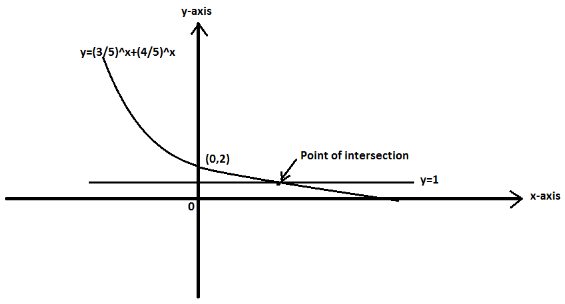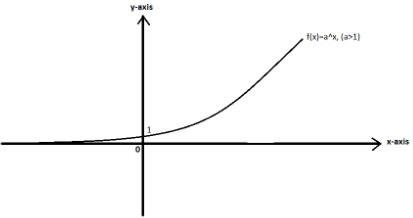
If $f(x) = {(\dfrac{3}{5})^x} + {(\dfrac{4}{5})^x} - 1;x \in R$ , then equation f(x) =0 has:-
A) No solution
B) One solution
C) Two solutions
D) More than two solutions
Answer
576.9k+ views
Hint: Here in this question we will use a graphical approach for solving. For this two functions graph should be known. First graph is of ${a^x}$ which is increasing for a>1 value and another is of constant value. So we will compare both graphs and will see intersection points between two graphs. Points of intersection will give a number of total solutions.
Complete step-by-step answer:
$f(x) = {(\dfrac{3}{5})^x} + {(\dfrac{4}{5})^x} - 1;x \in R$ Now in question it is asked number of solutions when f(x) will be equal to zero.
$ \Rightarrow {(\dfrac{3}{5})^x} + {(\dfrac{4}{5})^x} - 1 = 0$
$ \Rightarrow {(\dfrac{3}{5})^x} + {(\dfrac{4}{5})^x} = 1$
Now as we can see the left side function is of the form ${a^x}$ but here the value of ‘a’ is less than zero so the graph will be decreasing. And on the right hand side there is a constant value ‘1’ whose graph will be straight parallel to the x-axis.
Now we will find points for graph ${(\dfrac{3}{5})^x} + {(\dfrac{4}{5})^x}$
$y = {(\dfrac{3}{5})^x} + {(\dfrac{4}{5})^x}$ (Y is the point on y-axis)
$ \Rightarrow y = {(\dfrac{3}{5})^0} + {(\dfrac{4}{5})^0}$ (Putting x=0)
$ \Rightarrow y = 1 + 1 = 2$ ()
So, points on y-axis will be (0, 2)
Now we will plot the graph with the help of these points.

As we can observe from above that both graphs are intersecting at only one point therefore only one solution will be there for the function ${(\dfrac{3}{5})^x} + {(\dfrac{4}{5})^x} - 1 = 0$ ,we can find that solution as follows: -
$ \Rightarrow {(\dfrac{3}{5})^x} + {(\dfrac{4}{5})^x} = 1$
$ \Rightarrow \dfrac{{{3^x}}}{{{5^x}}} + \dfrac{{{4^x}}}{{{5^x}}} = 1$ (Applying identity ${(\dfrac{a}{b})^x} = \dfrac{{{a^x}}}{{{b^x}}}$ )
Now we will take L.C.M
$ \Rightarrow \dfrac{{{3^x} + {4^x}}}{{{5^x}}} = 1$
$ \Rightarrow {3^x} + {4^x} = {5^x}$
Now we will put values of x and will see if L.H.S=R.H.S
When x=1, ${3^1} + {4^1} \ne {5^1}$
When x=2, ${3^2} + {4^2} = {5^2}$
$ \Rightarrow 9 + 16 = 25$
Therefore from the graph as well as by obtaining the value we observed that there is only one solution which is x=2 for equation when it is equal to zero.
Hence correct option is (A).
Note: Students may likely to be confused in understanding the graph of ${a^x}$ so below graph is mentioned:-

From above we can see that the function is always increasing for all values greater than one because at equal to one it will be a constant graph parallel to x-axis.
Complete step-by-step answer:
$f(x) = {(\dfrac{3}{5})^x} + {(\dfrac{4}{5})^x} - 1;x \in R$ Now in question it is asked number of solutions when f(x) will be equal to zero.
$ \Rightarrow {(\dfrac{3}{5})^x} + {(\dfrac{4}{5})^x} - 1 = 0$
$ \Rightarrow {(\dfrac{3}{5})^x} + {(\dfrac{4}{5})^x} = 1$
Now as we can see the left side function is of the form ${a^x}$ but here the value of ‘a’ is less than zero so the graph will be decreasing. And on the right hand side there is a constant value ‘1’ whose graph will be straight parallel to the x-axis.
Now we will find points for graph ${(\dfrac{3}{5})^x} + {(\dfrac{4}{5})^x}$
$y = {(\dfrac{3}{5})^x} + {(\dfrac{4}{5})^x}$ (Y is the point on y-axis)
$ \Rightarrow y = {(\dfrac{3}{5})^0} + {(\dfrac{4}{5})^0}$ (Putting x=0)
$ \Rightarrow y = 1 + 1 = 2$ ()
So, points on y-axis will be (0, 2)
Now we will plot the graph with the help of these points.

As we can observe from above that both graphs are intersecting at only one point therefore only one solution will be there for the function ${(\dfrac{3}{5})^x} + {(\dfrac{4}{5})^x} - 1 = 0$ ,we can find that solution as follows: -
$ \Rightarrow {(\dfrac{3}{5})^x} + {(\dfrac{4}{5})^x} = 1$
$ \Rightarrow \dfrac{{{3^x}}}{{{5^x}}} + \dfrac{{{4^x}}}{{{5^x}}} = 1$ (Applying identity ${(\dfrac{a}{b})^x} = \dfrac{{{a^x}}}{{{b^x}}}$ )
Now we will take L.C.M
$ \Rightarrow \dfrac{{{3^x} + {4^x}}}{{{5^x}}} = 1$
$ \Rightarrow {3^x} + {4^x} = {5^x}$
Now we will put values of x and will see if L.H.S=R.H.S
When x=1, ${3^1} + {4^1} \ne {5^1}$
When x=2, ${3^2} + {4^2} = {5^2}$
$ \Rightarrow 9 + 16 = 25$
Therefore from the graph as well as by obtaining the value we observed that there is only one solution which is x=2 for equation when it is equal to zero.
Hence correct option is (A).
Note: Students may likely to be confused in understanding the graph of ${a^x}$ so below graph is mentioned:-

From above we can see that the function is always increasing for all values greater than one because at equal to one it will be a constant graph parallel to x-axis.
Recently Updated Pages
A man running at a speed 5 ms is viewed in the side class 12 physics CBSE

The number of solutions in x in 02pi for which sqrt class 12 maths CBSE

State and explain Hardy Weinbergs Principle class 12 biology CBSE

Write any two methods of preparation of phenol Give class 12 chemistry CBSE

Which of the following statements is wrong a Amnion class 12 biology CBSE

Differentiate between action potential and resting class 12 biology CBSE

Trending doubts
What are the major means of transport Explain each class 12 social science CBSE

Which are the Top 10 Largest Countries of the World?

Draw a labelled sketch of the human eye class 12 physics CBSE

How much time does it take to bleed after eating p class 12 biology CBSE

Explain sex determination in humans with line diag class 12 biology CBSE

Explain sex determination in humans with the help of class 12 biology CBSE




